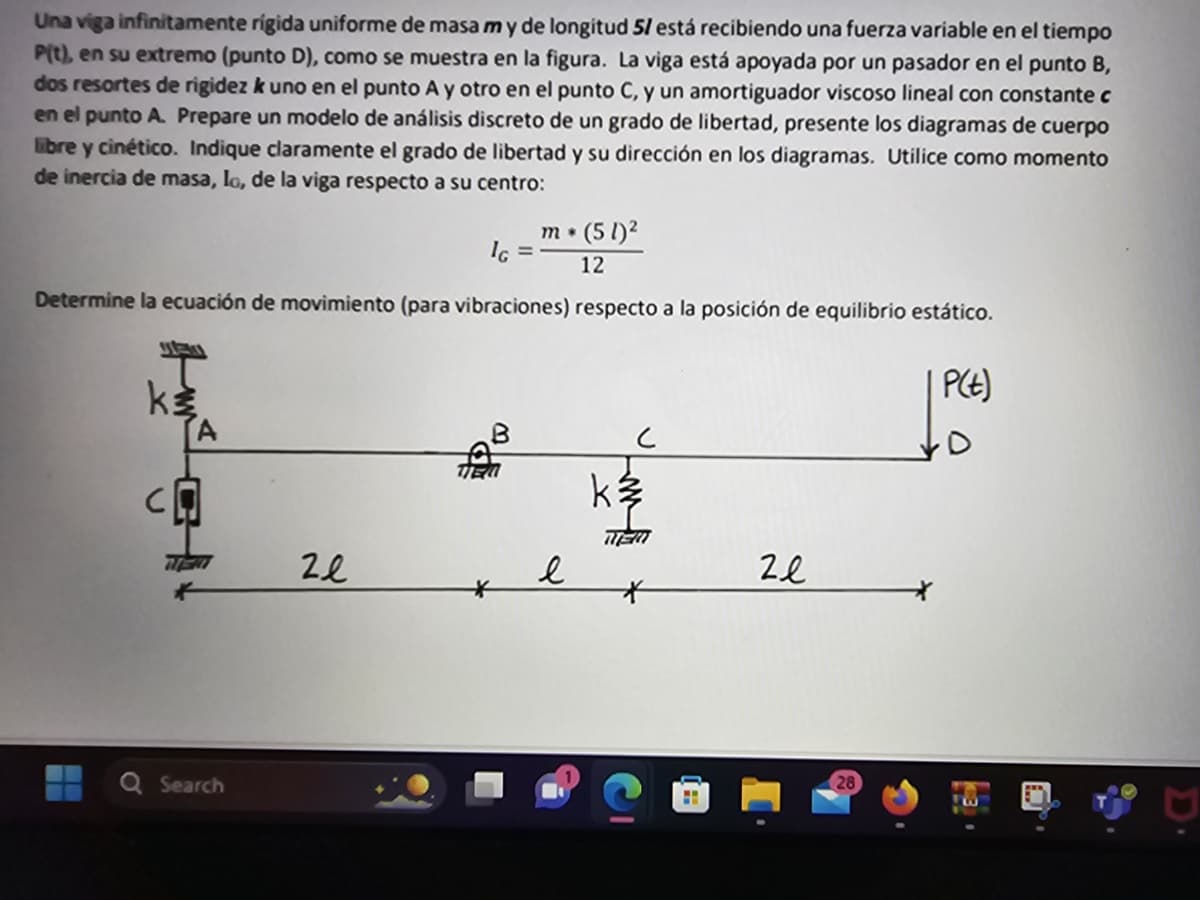A uniform infinitely rigid beam of mass m and length 5/ is receiving a time-varying force P(t), at its end (point D), as shown in the figure. The beam is supported by a pin at point B, two springs of stiffness k, one at point A and one at point C, and a linear viscous damper with constant c at point A. Prepare a discrete analysis model of a degree of freedom, present the free body and kinetic diagrams. Clearly indicate the degree of freedom and its direction on the diagrams. Use as the mass moment of inertia, Io, of the beam with respect to its centerDetermine the equation of motion (for vibrations) with respect to the static equilibrium position
A uniform infinitely rigid beam of mass m and length 5/ is receiving a time-varying force P(t), at its end (point D), as shown in the figure. The beam is supported by a pin at point B, two springs of stiffness k, one at point A and one at point C, and a linear viscous damper with constant c at point A. Prepare a discrete analysis model of a degree of freedom, present the free body and kinetic diagrams. Clearly indicate the degree of freedom and its direction on the diagrams. Use as the mass moment of inertia, Io, of the beam with respect to its centerDetermine the equation of motion (for vibrations) with respect to the static equilibrium position
Principles of Heat Transfer (Activate Learning with these NEW titles from Engineering!)
8th Edition
ISBN:9781305387102
Author:Kreith, Frank; Manglik, Raj M.
Publisher:Kreith, Frank; Manglik, Raj M.
Chapter5: Analysis Of Convection Heat Transfer
Section: Chapter Questions
Problem 5.2P: 5.2 Evaluate the Prandtl number from the following data: , .
Related questions
Question
A uniform infinitely rigid beam of mass m and length 5/ is receiving a time-varying force P(t), at its end (point D), as shown in the figure. The beam is supported by a pin at point B, two springs of stiffness k, one at point A and one at point C, and a linear viscous damper with constant c at point A. Prepare a discrete analysis model of a degree of freedom, present the free body and kinetic diagrams. Clearly indicate the degree of freedom and its direction on the diagrams. Use as the mass moment of inertia, Io, of the beam with respect to its centerDetermine the equation of motion (for vibrations) with respect to the static equilibrium position

Transcribed Image Text:Una viga infinitamente rigida uniforme de masa m y de longitud 51 está recibiendo una fuerza variable en el tiempo
P(t), en su extremo (punto D), como se muestra en la figura. La viga está apoyada por un pasador en el punto B,
dos resortes de rigidez k uno en el punto A y otro en el punto C, y un amortiguador viscoso lineal con constante c
en el punto A. Prepare un modelo de análisis discreto de un grado de libertad, presente los diagramas de cuerpo
libre y cinético. Indique claramente el grado de libertad y su dirección en los diagramas. Utilice como momento
de inercia de masa, lo, de la viga respecto a su centro:
m. (51)²
IG =
12
Determine la ecuación de movimiento (para vibraciones) respecto a la posición de equilibrio estático.
TEM
k
Search
2 l
е
C
k 3
MEM
*
2l
28
P(t)
Expert Solution
This question has been solved!
Explore an expertly crafted, step-by-step solution for a thorough understanding of key concepts.
Step by step
Solved in 3 steps with 7 images

Recommended textbooks for you

Principles of Heat Transfer (Activate Learning wi…
Mechanical Engineering
ISBN:
9781305387102
Author:
Kreith, Frank; Manglik, Raj M.
Publisher:
Cengage Learning

Principles of Heat Transfer (Activate Learning wi…
Mechanical Engineering
ISBN:
9781305387102
Author:
Kreith, Frank; Manglik, Raj M.
Publisher:
Cengage Learning